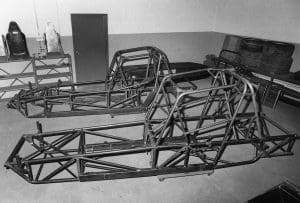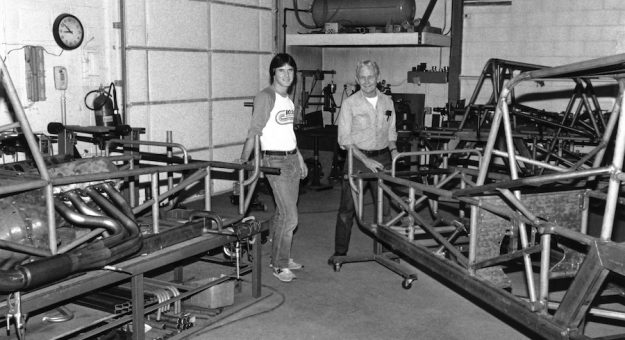From the Pettys to the Kinsers and the Coughlins, racing sons often follow racing fathers into the cockpit as drivers. It’s one of the great traditions of the sport.
What’s considerably less common is to see a perfectionist driver, with masterful metalworking skills, successfully transition into a racing businessman, aided by an equally committed son who, by all indications, never raced in competition.
They were a dynasty writ large in steel tubing, sheet aluminum and welding sticks.
The history of the northeast’s acclaimed Olsen family is an unusual one, first for its relentless pursuit of consistent excellence in every aspect of its achievements.

Budd Olsen — his given name, incidentally, was Purdy — was a child of the postwar boom in motorsports that took him from sprint cars into stockers as they evolved into modifieds. In sprint cars, Olsen was the 1951 National Auto Racing Ass’n champion. Two years earlier, he finished 12th in a NASCAR Strictly Stock race at Langhorne (Pa.) Speedway.
Yet, it was modifieds that cemented the legacy of the Olsens, both Budd and his son Doug, in their chosen branch of motorsports. The Olsen Eagle, as their purpose-built race car was called, became the dominant dirt modified chassis of the 1980s.
Born in New Jersey in 1924, Budd Olsen was part of a modified community that grew in the region, particularly during the 1950s. The Olsen family was native to towns like Paulsboro, Gibbstown and West Deptford. Following regular wins at Alcyon Speedway in Pitman and at Pennsylvania’s Nazareth Raceway, Olsen made a forceful run at the 1958 NASCAR modified title, winning a dozen races in 90 starts aboard the Busty Luzo Ford coupe to seize the championship.
This story involves multiple people and cars. Olsen went on to drive modifieds for a host of top-tier owners, including The Deuce of Lucky Jordan out of Riverton, N.J., the Harold Cope 1, the famed No. 111 Maul Missile, the No. 39 “Polecat” of Dave Piscopo, the Cozze brothers No. 44 coach and his own, famed “Lightning Zero” coupe.
“He was meticulous,” said New Jersey racing journalist Buffy Swanson, who also chairs the Northeast Dirt Modified Museum and Hall of Fame, where Olsen is enshrined. “Everything about the man was meticulous. Everything had to be just so. Professional looking. Up to snuff. Never a hair out of place. He never looked like a grease monkey. He always presented himself as a professional, and as a gentleman. That’s just the way he was. It was just ingrained in him. If he was going to do something, he was going to do it the best, and look the best, and be the best, and be with his gorgeous wife, Audrey, who he was together with for 40 years.”
Audrey Olsen, nee McLaughlin, brought another person into Budd Olsen’s life, his brother-in-law Jackie McLaughlin, who proved to be a modified prodigy and a prolific winner. McLaughin was already on an escape-velocity ride to stardom when he was killed at Nazareth in 1964.
Rocked by the tragedy, Olsen nevertheless recovered to win the 1964 Reading Fairgrounds title for Piscopo. Around this time, Olsen produced his first modified for a paying customer, when he created a Chevrolet coupe for the Cozze brothers.
It was a deal that would make a duopoly and a dynasty, enveloping both Budd and Doug, an erstwhile schoolteacher. Budd Olsen continued driving until 1973, when he brought his Pinto-bodied modified home seventh at Syracuse and unceremoniously stepped out of the driver’s seat for good.
Olsen’s friend Dick Tobias had slowly edged into building assembly line modifieds for customers. Focusing on the same Pennsylvania-New Jersey-New York clientele, Olsen, as Swanson explained, first bought a set of Tobias blueprints, welded the tubing, added his own touches and lovingly finished a new modified. Then, he sold it to an eager customer. It was the opening gambit for what became Budd Olsen Speed Supplies, a full-on race car factory based off Interstate 295 in Mickleton, N.J., just up the road from Bridgeport Speedway, where a lot of Olsen creations got a shakedown.
Tobias, Olsen and within a few years, Troyer Engineering, transformed the modified from a highly individualistic, home-built piece into a top-to-bottom specialty race car fabricated from in-house specialized components.
By most estimates, Budd Olsen Speed Supplies is estimated to have produced some 200 race cars. The first “house” or factory car went to future Syracuse winner Frank Cozze in the late 1970s. A little later, the all-conquering Brett Hearn got one, too, followed by the late Doug Hoffman.
